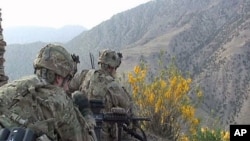U.S.-led coalition forces in Afghanistan are striking back against the Taliban's annual spring offensive with helicopter raids targeting a key border area that has long served as a base for the insurgents.
U.S. Army paratroopers with the 101st Airborne Division fly into a remote district of eastern Paktika province, bordering Pakistan. Bermel district is a key battleground in a new NATO plan for securing Afghanistan, 10 years after the U.S.-led invasion.
Traditionally, the Taliban launches new attacks every spring after spending the winter across the border in Pakistan. The Taliban spring offensive means more improvised explosive devices and more combat.
This year NATO hopes to seize the initiative, by deploying thousands of reinforcements along the Taliban's supply lines, especially in Bermel and other border districts. The Bermel interdiction began with the April reconnaissance patrol by the 101st Airborne Army paratroopers, led by Captain Chris Tanner.
"This is a standard reconnaissance mission into northern Bermel along a historic infiltration route from Pakistan," said Bermel. "The terrain is very inaccessible. We're going in there to see what the terrain is like, to develop it for future operations."
In Bermel, the paratroopers spend hours tracking suspected Taliban and mapping their fighting positions. The Taliban respond with sporadic rocket fire. The Americans fire mortars in response.
The two-day patrol ends with no casualties on either side, though six Americans died a few days earlier in a similar assault in neighboring Kunar province.
The Bermel mission gives Tanner reason to hope.
"We receive, historically, a lot of indirect artillery and rocket fire," he said. "If we can get those numbers to decrease, and also the amount of IED-making material we see moving farther into Afghanistan - it all crosses the border here... so if we can interdict those supplies, it has a significant impact on insurgent activities throughout the region."
The bigger issue is whether NATO can sustain its counter-offensive and retain the initiative.
The U.S. is scheduled to begin withdrawing a small portion of its100,000 troops from Afghanistan in July.










